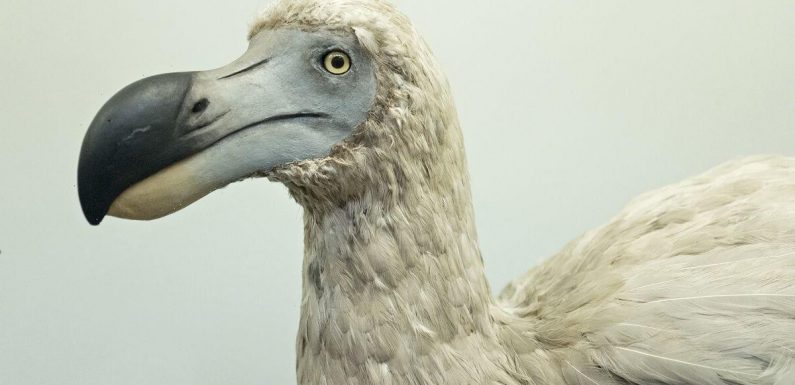
Russia: Discovery of woolly mammoth remains raises cloning hopes
We use your sign-up to provide content in ways you’ve consented to and to improve our understanding of you. This may include adverts from us and 3rd parties based on our understanding. You can unsubscribe at any time. More info
The dodo — the iconic flightless bird from Mauritius driven to extinction by humans in the 17th century — could be brought back to life. This is the promise of the Dallas, Texas-based startup Colossal Biosciences, who are looking to use stem cell technology and gene editing to “de-extinct” the hapless species as part of a £121million project. The plans follow on from the sequencing of the dodo’s complete genome by evolutionary molecular biologist Professor Beth Shapiro of University of California, Santa Cruz and her colleagues last year.
Professor Shapiro said: “There has never been more urgency to preserve species than there is today.”
She added: “It’s not just important for their continued existence. It’s for the greater good of the planet.
“Together, Colossal and the scientific community at large are committed to our efforts to de-extinct those we’ve lost.”
Other species in Colossal’s cross-hairs for de-extinction include the Tasmanian tiger — or “thylacine”, to use its proper name — and lost megafauna like the woolly mammoth.


In life, dodos grew to be just over three feet tall, and are thought to have weighed in at around 23–39 lbs.
It inhabited the woods in the drier coastal areas of Mauritius — an island in the Indian Ocean some 560 miles east of Madagascar — and, despite its undeserved reputation as being fat and clumsy, was in fact very well adapted for its ecosystem.
Unfortunately, the lack of significant predators on Mauritius prior to the arrival of humans had led not only to the dodos becoming flightless, but also quite fearless of humans.
The first recorded mention of the dodo comes from the records of Dutch sailors back in 1598. In the subsequent years, predation by humans for food — combined with habitat loss and the introduction of invasive species like dogs, pigs, cats and rats — caused dodo numbers to dwindle.


The last widely-accepted sighting of the dodo is now held to have been made in the year 1662 — although the fact of its extinction was not recognized until the 19th century.
This was in part because religious doctrine said that extinction was not possible, but also because in the absence of physical evidence many scientists believed that the unlikely-sounding bird was a myth.
However, studies have been undertaken both on the remains of a limited number of specimens that were transported to Europe in the early 17th century, as well as so-called subfossils recovered from the Mare aux Songes swamp on the east of Mauritius.
The dodo has since become the “poster child” for the risk of extinction, drawing attention to how human activities have the potential to kill off entire species.
DON’T MISS:
North Sea boost as energy giant says oil and gas crucial for decades [REPORT]
Solar panel owners are ‘more at risk of scams’ thanks to crafty tool [ANALYSIS]
Major UK energy supplier mulls plans to exit UK after Bulb [INSIGHT]

Colossal Biosciences said: “The dodo bird is a symbol of man-made extinction — a glaring example of the price of carelessness.
“Colossal is committed to reviving species lost to extinction in an effort to build a better world.
“Therefore, it is our intention to partner with the government of Mauritius to establish a foundation for the de-extinction and rewilding of the beloved bird we all dearly miss.
“And finally, the people of Mauritius have been patiently waiting for the dodo’s return, doing their part to care for their habitat and keeping the land in a natural, healthy state.”
To bring back the dodo from the dead, the researchers propose to edit the genome of a closest modern-day, living relative of the lost bird.
Specifically, they would use the Nicobar pigeon, a colourful blue-and-green bird that lives on small islands and coastal regions all the way from the Andaman and Nicobar Islands off of the east coast of India to the Republic of Palau.
Having edited the DNA of a Nicobar pigeon’s stem cell to approximate that of a dodo’s genetic code, the team would use that cell to create an embryo that could be carried to term in a surrogate bird.
Bringing back a bird provides an additional challenge in comparison to resurrecting mammal species, Prof, Shapiro notes, as birds have relatively intricate reproductive pathways.
Just because scientists might be able to bring back the dodo doesn’t mean, however, that it is a wise idea.
For many experts, the notion of de-extinction opens a can of worms about ethics, our responsibility to existing species, and the question of whether a recreated dodo would even really be what it superficially seems.
As Geneticist Jennifer Li Pook Than of Stanford University told the MIT Technology Review: “It would not really be a dodo — it would be a new species.
“But it still needs an environment. What would that mean, ethically, if one is not available?”
Source: Read Full Article